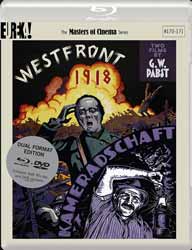|
Click here to return to the main site. Blu-ray & DVD Review
Georg Wilhelm Pabst (1885 – 1967) was an Austrian film and theatre director who was most active in the period between the first and second word wars, although he continued to work in the post war environment completing his final film, Through the Forests and Through the Trees in nineteen fifty-six. His interests ranged from pure fantasy, L'Atlantide (1932), Don Quixote (1933) through to musicals, The Threepenny Opera (1931). He started in silent films and successfully transitioned to talkies, with Westfront 1918 being generally considered his first talkie. While much of his work could be considered non-controversial, there are few who lived through the horrors of the First World War that remained untouched by the violence. Pabst reaction to these events surfaced in his film, Westfront 1918 and Kameradschaft both of which are included in a single Blu-ray disc. Westfront 1918 (1930. 1 hr, 36 min, 10 sec), directed by Pabst from a Ernst Johannsen script is very much an anti-war film, so much so that it garnered the displeasure of the Nazi party who needed an unquestioning populous in its military adventures. Like most early films there are cuts of various lengths, depending on the target audience. The film is set in the final bloody year of the first world war, a war of attrition which saw in excess of forty-one million people either killed or wounded and contributed to the spread, in nineteen eighteen, of the Spanish flu which killed between forty to fifty million people. Loss on this scale had not been seen since the advent of the Black Death in the fourteenth century which killed sixty percent of the European population. What is worse is that humans predominantly did this to themselves. The experience left Padst with strong pacifistic leanings, which are demonstrated in the film. Through all the death and meaningless destruction Padst chose to end his film with the enduring image of a dead German soldier’s hand being taken by an injured Frenchman who exclaims “comrades, not enemies” and the last title screen leaves the audience with the question ’End?’. The film follows four soldiers, who after a few days leave have to return to the front. Here Pabst does some of his best work. Not shy of the realities of war he depicts the boredom, stupidity and horror with clarity. The four live and possibly die in a horrific landscape made of blood and mud, where bodies of dead comrades are left where they fall, often buried, only a hand showing. He returned to the theme of comradeship across divides with his film, Kameradschaft (1931. 1 hr, 29 min, 42 sec). The film was based on an actual mining disaster which claimed the lives of over a thousand people. Following the end of the First World War the map of Europe was redrawn in favour of the victors, however this threw up a number of anomalies. On the border between France and Germany a mine finds itself straddling the border so it is decided that the mine should be cut in two by means of a barrier. With the end of the war and the resultant economic downturn tensions remain between the two communities as Germans and French compete for jobs. When a fire breaks out in the French part of the mine both communities come together in order to rescue the miners. The barrier is torn down in an effort to access a portion of the mine. Headless of the danger to themselves the German mine workers leave their homes to rescue fellow miners. The ending is not dissimilar to that of Westfront 1918 where hope that we can learn to work and live together is brought low by external forces. While the two communities celebrate the return of their loved ones the mine owner quietly re-establish the barrier separating the mine and the communities. Given the age of the films and the fact that they had to be reconstructed prior to their 2k Blu-ray restoration they have survived remarkably well. Both films get an informative visual introduction from Jan-Christopher Horak. The Nazi’s may not have liked his socialist, anti-war leanings, but the film's messages are just as potently relevant today. 7 Charles Packer Buy this item online
|
|---|

